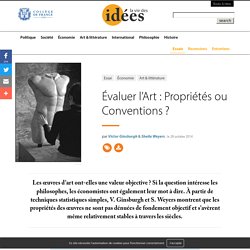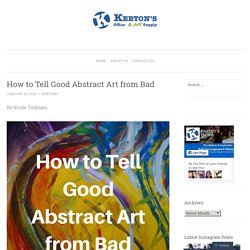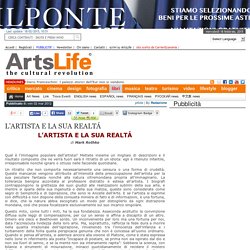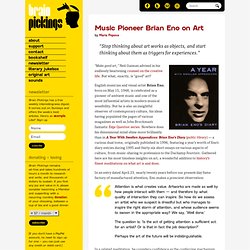

Critical Analysis. Les Archives de la critique d'art : des ressources sur l'art contemporain. Évaluer l’Art : Propriétés ou Conventions. Demandez à un crapaud ce que c’est que la Beauté.

Il vous répondra que c’est sa femelle avec deux gros yeux ronds sortant de sa petite tête, une gueule large et plate, un ventre jaune, un dos brun (Voltaire, Dictionnaire philosophique). Les philosophes de l’art se sont beaucoup intéressés à l’existence implicite ou explicite de propriétés dont seraient dotées les œuvres d’art. Il est remarquable que les économistes ont, eux aussi, proposé de décomposer les objets banals en caractéristiques.
Nous profiterons de cette approche commune à deux sciences qu’on pourrait croire éloignées, pour tirer des propositions de l’une comme de l’autre et essayer d’aboutir à une évaluation des œuvres d’art fondée sur un principe d’objectivité. La Balance des Peintres Dans son Cours de peinture par principes, Piles (1708) distingue quatre propriétés (composition, dessin, coloris et expression) et évalue sur cette base 56 peintres « les plus connus ». Les propriétés vues par les philosophes et les économistes. How to Tell Good Abstract Art from Bad. By Nicole Tinkham When looking at a famous abstract painting do you ever think “I could do that”?

If you’re wondering how something so simple can be considered a masterpiece, you’re not alone. Is it really as easy as we think or is there true artistic talent behind these works of art? Believe it or not, there’s science proving that there is in fact a difference between a painting done by a professional and random splatters on a canvas. Before trying to re-create a masterpiece hoping to make millions, pay attention to this blog and see what the experts have to say as well as what to look for in a professionally done piece. The Research A study done by two psychologists shows that statistically people CAN tell an abstract painting done by a professional artist vs a child, chimp, gorilla, elephant, or monkey.
What to look for in “good” abstract art 1. 2. Analyser une oeuvre d'art contemporain. Analyse d'oeuvres d'art. Analyse d'oeuvre : Guernica de Pablo Picasso. L'ARTISTA E LA SUA REALTÁ - ArtsLife. Di Mark Rothko Qual è l’immagine popolare dell’artista?

Mettete insieme un migliaio di descrizioni e il risultato composito che ne verrà fuori sarà il ritratto di un idiota: egli è ritenuto infantile, irresponsabile nonché ignaro o ottuso nelle faccende quotidiane. Un ritratto che non comporta necessariamente una censura o una forma di crudeltà. Queste mancanze vengono attribuite all’intensità della preoccupazione dell’artista per la sua peculiare fantasia nonché alla natura oltremondana propria all’immaginario.
La tolleranza benigna accordata al professore distratto è estesa all’artista. Questo mito, come tutti i miti, ha la sua fondatezza. Per quanto possa sembrare strano, l’artista non si è mai lamentato nel vedersi rifiutate quelle virtù degne di stima di cui glia altri uomini non potrebbero fare a meno: capacità intellettive e discernimento, conoscenza del mondo e condotta razionale. OperaViva Magazine, un'arte del possibile — Filosofia e forme di vita. SensCritique - Critiques de Films, Livres, Jeux Video, Séries, BD, Musique. Music Pioneer Brian Eno on Art. By Maria Popova “Stop thinking about art works as objects, and start thinking about them as triggers for experiences.”

“Make good art,” Neil Gaiman advised in his endlessly heartening counsel on the creative life. But what, exactly, is “good” art? English musician and visual artist Brian Eno, born on May 15, 1948, is celebrated as a pioneer of ambient music and one of the most influential artists in modern musical sensibility. But he is also an insightful observer of contemporary culture, his ideas having populated the pages of various magazines as well as John Brockman’s fantastic Edge Question series. In an entry dated April 23, nearly twenty years before our present-day fame factory of manufactured attention, Eno makes a prescient observation: Attention is what creates value.
In a related meditation, he considers confidence as the conferring mechanism of value: The term “confidence trick” has a bad meaning, but it shouldn’t. Where do you work? William H. Changing ourselves. Susan Sontag on the Creative Purpose of Boredom. Susan Sontag on Beauty vs. Interestingness. By Maria Popova Defying consumerism and the banality of the beautiful, or why our capacity for astonishment endures.

“Attitudes toward beauty are entwined with our deepest conflicts surrounding flesh and spirit,” Harvard’s Nancy Etcoff wrote in her fantastic meditation on the psychology of beauty. Indeed, beauty is a complex beast surrounded by our equally complex attitudes, and who better to tease those complexities apart than the greatest public intellectual of the twentieth century? Months before her death, Susan Sontag — who had a lifetime of strong opinions on art and who coined the notion of “aesthetic consumerism” — wrote a spectacular essay titled “An Argument Against Beauty,” found in the 2007 posthumous anthology At the Same Time: Essays and Speeches (public library), the superb volume that gave us Sontag on courage and resistance and literature and freedom. Sontag writes: The subtraction of beauty as a standard for art hardly signals a decline of the authority of beauty.
(134) How to Sound like you Understand Art.